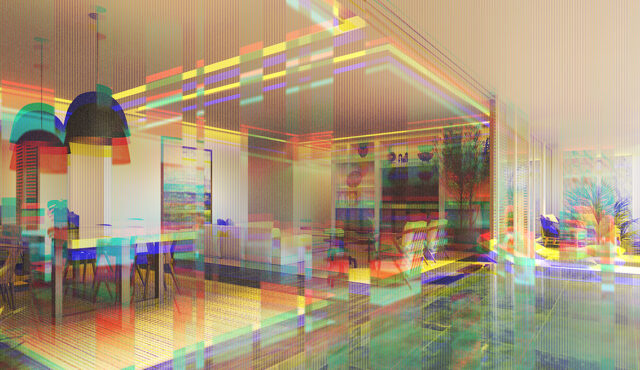This trend hits close to home.
When you think of “wellness,” real estate may not be the first (or second… or 12th) thing that comes to mind—but that may soon change as residential real estate experiences a health overhaul. In 2024 and beyond, the concept of wellness at home will be a driving factor in the way houses and apartments are built and renovated, thanks to a growing understanding among buyers and renters that our living environment impacts our overall health.
As of 2022 (the latest report available), the wellness real estate market was valued at nearly $400 billion, according to the Global Wellness Institute (GWI), which defines wellness real estate as “homes that are proactively designed and built to support the holistic health of their residents” and held a dedicated symposium on the topic in May. Looking ahead, GWI predicts that the wellness real estate market will grow at a compound annual growth rate (CAGR) of 17.4 percent to reach more than $887 billion by 2027. Currently, the U.S. has the largest market share of any country in the world.
In a lot of ways, the desire to dwell in a space that’s as supportive of you feeling your best is a natural extension of the increasingly mainstream interest in holistic health. “Food and beverage went through this over the last 15, 20 years where people all of a sudden knew what non-GMO foods were, what organic foods were—and we’re at the very beginning of that trend with wellness real estate,” says Landy F. Labadie, vice president of community solutions for FirstService Residential, the largest property management company in North America.
Indeed, data shows that people are more steadily looking to their homes as spaces to enhance their well-being. In a 2023 healthy home survey of nearly 1,300 homeowners and renters of single-family homes conducted by real estate market research firm John Burns Research & Consulting, 95 percent of respondents said they believe their home impacts their health, and 73 percent said their health will be a deciding factor when choosing their next home.
What constitutes a healthy home, though, can and will vary depending on factors like the geographic location and the preferences of the people living in it, as well as their level of disposable income. But in general: “People are focused on air quality, water quality, lighting, and other elements that help enhance sleep, energy levels, respiratory outcomes, cardiovascular outcomes, and more,” says Paul Scialla, founder and CEO of Delos Living, a real estate company founded in 2012 that focuses on integrating wellness features into building designs. In 2014, Delos launched the Well Building Standard, which measures attributes of buildings that impact occupant health, like air quality and light. Since then, thousands of developers across commercial and residential real estate have adopted the standard. In the past two years alone, the number of Well Certified spaces have quadrupled, with more than 4 billion square feet of real estate currently enrolled, according to Delos.
“People are focused on air quality, water quality, lighting, and other elements that help enhance sleep, energy levels, respiratory outcomes, cardiovascular outcomes, and more.”
Paul Scialla, founder and CEO, Delos Living
In recent months, relaxation-boosting home amenities have become a heightened priority, according to Khoi Vo, CEO of the American Society of Interior Designers (ASID). “This can include a dedicated room with spa-like amenities,” he says, citing a trend that’s also shaping the design of bathrooms. In the National Kitchen and Bath Association’s 2024 Bath Trends Report, which was compiled based on a survey of more than 500 industry professionals, the most popular shower features noted all contribute to the creation of a spa-like atmosphere: rain showers, steam showers, and showers with built-in seating.
Vo adds that designers have also seen increased demand for more efficient and effective heating, ventilation, and air conditioning (HVAC) systems to improve air quality, citing that the HVAC market in North America is expected to grow by $8.62 billion between 2023 and 2028. Indoor air quality was also the number-one healthy home feature that respondents to the above John Burns Research & Consulting survey said they cared about, and 69 percent said they believe air filtration systems should be included as standard in newly built homes.
But really, the hallmarks of a healthy home can vary greatly depending on your budget. For people looking in the luxury space, “cold plunge pools are huge right now,” says Labadie, whose company manages the residential building 53W53 above the Museum of Modern Art in midtown Manhattan; the building features a 15,000-square-foot wellness center and spa treatment room. In fact, cold plunge pools were also among Zillow’s top six home trends for 2024, of which two others were also wellness-focused: pickleball courts and sensory gardens, or green spaces designed to stimulate some combination of the five senses.
“We’re seeing cryotherapy being a big one that people are starting to ask for,” adds Labadie, speaking on the luxury market. “We’re also seeing some demand now for medical recovery centers where people can have outpatient procedures done in their residences and be able to recover in their own building without having to go outdoors.”
Unsurprisingly, the higher up the income ladder you climb, the more deluxe the wellness home features become. Luxury properties with wellness baked into their very DNA are like the Erewhons of the real estate world—places where the healthy options are both extensive and expensive.
For starters, there are the private residences of luxury wellness resort Six Senses Ibiza (which debuted in 2022), offering all the access and amenities provided to hotel guests. Among them is admittance to its longevity club Rosebar, which features an extensive list of offerings aimed at helping people repair and rebalance their bodies on a cellular level, including hyperbaric chambers, IV infusions, cryotherapy, and access to on-site doctors and health coaches offering everything from nutrition support to hormonal consultations and advanced diagnostics.
Then there’s Velvaere, a wellness-centric mountainside residential community in Park City, Utah. The first of its planned 115 ski-in, ski-out residences will be completed in 2024. This year, Velvaere also partnered with Fountain Life, a company that focuses on preventative health care and longevity, to offer future residents access to precision diagnostic screenings.
In early 2024, Sha Wellness Clinic, a pioneer in integrated medical and holistic wellness, will launch its first wellness residences (through its new real estate development firm AB Living Group) in Costa Mujeres, Mexico. The property will offer classes in cooking, meditation, yoga, mindfulness, and more, through its Healthy Living Academy, as well as a suite of treatments including acupuncture and aesthetic dermatology services.
Meanwhile, New York City–based holistic wellness center The Well will open its first residential building (including an on-site wellness facility) in December 2024 in Miami’s Bay Harbor Islands. According to The Well, more than half of the residences sold before construction even began. Miami will also become home to the world’s first Blue Zones Center in 2025. The well-being hotel and residential property will include a large-scale medical center geared toward helping people live their longest, healthiest lives through a combination of modern medicine, holistic healing, and technology. The offerings will include surgical, aesthetic, and therapeutic practices, as well as well-being programming that takes the lifestyles of the longest-living people on Earth into account.
While wellness real estate currently caters primarily to affluent consumers, there are signs that the industry aims to expand its reach into relatively more accessible territory. On the mass market front, Homz, a wellness-centric, multi-family housing developer, raised $50 million in seed funding in March to start building attainable rental housing communities across the South. And Gravity, a real estate project in Columbus, Ohio, that its developer, Brett Kaufman, calls “the world’s largest conscious living community,” just completed its second phase of development of a mixed-use space. The property includes apartments, offices, restaurants, retailers, and indoor and outdoor gathering spaces where it offers group wellness programming, like incense-making, morning yoga, and transcendental meditation classes. Its third phase will include a spa-like, nature-inspired residential retreat.
Elsewhere, Scialla says retrofitting has also become a popular way to make healthy home improvements to existing residences—such as updates to ventilation systems, which can help improve air quality, and upgrades to insulation, which can treat dampness and mold, known respiratory agitators. “These types of solutions can often be implemented with little to no construction and can scale across large buildings and building portfolios,” he says. Not to mention, they’re typically more economical than starting from scratch and offer people who already have housing a chance to make their homes healthier.
In the U.S., the Environmental Protection Agency (EPA) says millions of homes will undergo retrofittings in the coming years to improve both energy efficiency and indoor air quality, thanks in part to newly available funding to help offset costs for consumers. The Biden Administration announced in March 2022 that it earmarked $3.16 billion for a residential retrofitting program called the Weatherization Assistance Program (WAP), in order to help make lower-income homes healthier and more energy efficient. WAP retrofit funding will focus on upgrades to insulation, heating and cooling systems, and electrical appliances, with an emphasis on addressing the “whole home,” according to a press release, which specifies that states, tribes, and territories can currently apply for WAP funding through the U.S. Department of Energy.
There’s also some evidence that retrofitting may help address health concerns and inequality in low-income and subsidized housing. In the United Kingdom, Arup, a global engineering and design consultancy, recently conducted research to assess all the potential benefits (beyond just cost savings) of retrofitting 54,000 low-income houses in Leeds to reduce carbon emissions and improve energy efficiency. Among its findings, Arup determined that updates to the air quality and energy efficiency of the homes improved occupants’ symptoms of anxiety and depression.
Looking further ahead, Scialla says renters’ and buyers’ increased interest in wellness amenities in real estate will help to make healthy-home features standard. A July 2023 study by market research firm Kantar found that wellness is the top factor driving U.S. adults’ home-related decisions. “As this trend continues, and as millennials and Gen Z consumers grow in buying power, the demand will grow exponentially,” says Scialla.
Such demand would ostensibly drive down costs, making at-home wellness amenities more affordable. So while you shouldn’t expect, say, cold therapy like cryo chambers or plunge pools to be commonplace across the wellness real estate market in the next couple of years, a future where these types of amenities are as easy to find as organic milk and produce is at your local grocery store isn’t so hard to imagine.
Hero Image: SHA Residences
Well+Good articles reference scientific, reliable, recent, robust studies to back up the information we share. You can trust us along your wellness journey.
- Mendell, Mark J et al. “Respiratory and allergic health effects of dampness, mold, and dampness-related agents: a review of the epidemiologic evidence.” Environmental health perspectives vol. 119,6 (2011): 748-56. doi:10.1289/ehp.1002410










